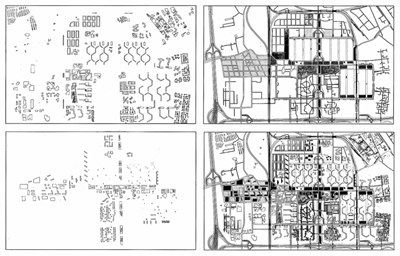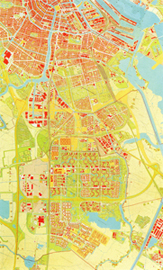You are in: Home page > Magazine Archive > When density gives sense to void spaces

Mauro Marzo
When density gives sense to void spaces
Rem Koolhaas, Bijlmermeer, 1986-87

OMA, Bijlmermeer. Comparison project - existing
The existence and persistence of phenomena of social and environmental deterioration in our cities, of voids that lack any quality, of underutilized “zoned” areas, all seem to be passively accepted by local municipal administrations, as the inevitable consequences of the onslaught of building development that has devastated regional landscapes from the Second World-War onwards into the 1980’s.
In only a few cases have local administrative agencies succeeded in transforming criticism into a resource and interpret the negative state of things as an opportunity to set forth processes of re-qualification for portions of urban areas lacking consistency.
It is hence no surprise that large swaths of public opinion share very little confidence in the possibility of restoring pockets of urban deterioration in our cities, holding the view that –at least in cases where city areas are most degraded- the only real solution is to demolish them.
It seemed that plans for demolition were starting to come forth also for the Bijlmermeer area, located south of Amsterdam, when, in 1986, the OMA group was called upon to prepare a redevelopment plan as an alternative to demolition.
As the central portion of a large suburb of social housing, the Bijlmermeer was built according to modernist-style residential building patterns with redents, housing blocks separated from major road-ways and endowed with ample spaces of greenery.
The urban landscape that resulted is not unlike that of countless other suburban extensions built between the 1950s and the 1970s around major urban centers of northern Europe. The in line building blocks are arranged according to a hexagonal pattern above an underground space -lacking any and all qualities–, designed for hosting commercial and social activities; while the road network is conversely elevated from the ground levels to connect to blocks of multi-levelled parking decks.
Despite all this, rather than judging the hopeless situation of that irrecoverable landscape, the OMA project aimed to highlight the specific potential of this area, to set the margins within which to operate for its requalification, and clarify what methods to use for the project-intervention.
Just one year before that, in 1985, Rem Koolhaas wrote a brief essay of great interest entitled The Terrible Beauty of the Twentieth Century, in which he illustrated the traits of a “systematic idealization” and the “automatic overestimation of what exists” that denote OMA’s project approach in sites characterised by widespread conditions of urban degradation.
As an archaeologist opening a new excavation, OMA conducted its analysis of the Bijlmermeer, paying attention to minimum details, in order to find traces of thought, architectural figures, and the remains of urban-planning models upon which to entrust the project of reactivating life in that part of the city.
Even in situations of the worst kind of deterioration –as Koolhaas’ writing points out- it is always possible to revive extant residuals of a “retroactive conceptual and ideological charge” that should be triggered for the requalification of urban spaces.
To recalibrate the excessively dilated urban fabric of this suburban outstretch, OMA’s redevelopment program focused on the specificity of relationships that was found to exist between the formation of built solids and the extents of open spaces.
The project restores significance to void spaces by: making them “dense” with activities through the transfer of functions that were once positioned in underground spaces; introducing store-fronts and services at the ground levels positioned beneath the roadway’s viaduct; enhancing the public greenery through landscape designs that distinguish between tree plantations and meadows, shrub borders and ponds; “densifying” the urban fabric through the insertion of newly built residential sections made up of homes with patios (influenced by Hilberseimer’s designs), urban houses (inspired by Unghers) and a number of high-rises that establish distant communication with the outstretch of the redents housing blocks.
The investigation conducted on the Bijlmermeer hence allowed for OMA to reveal both the area’s critical aspects and its potential, while formulating a project hypothesis centred on strategies of “urban densification” which, on the one hand, stood in contrast against public debates geared towards demolition, and on the other hand, suggested the foreshadowing of a "dense city"; one that is quite different from the Rome Interrupted project by Colin Rowe presented only a few years earlier.
It thus appears quite clear that the Bijlmermeer project undoubtedly constitutes a useful stepping stone to those who are presently dealing with the theme of “building densification” as a tool for project intervention geared towards the requalification of the contemporary city.
And yet, something more should be added.
To reread this project more than 25 years after it was drafted makes it in fact possible to verify the enduring relevance of Koolhaas’ early reflections on urban phenomena, and realize the architect’s unshakable certainty in regard to how even the fragments of value in the most degraded of urban areas can effectively constitute the methods and approaches to reality that are so vital to today’s strategies of planning and design.
Mauro Marzo is Tutor at PhD in Architectural Composition of the Doctoral School Iuav, Adjunct Professor of Architecture at the University of Parma and the IUAV University of Venice.
Bibliography
Koolhaas R. (1985). Le contexte: la splendeur terrifiante du XX siècle, L’Architecture d’aujour’hui, n. 238.
Lucan J. (1990). OMA. Rem Koolhaas, Milano: Electa.
Gargiani R. (2006). Rem Koolhaas/OMA, Roma-Bari: Laterza.

Area of Bijlmermeer, Amsterdam Zuidoost














